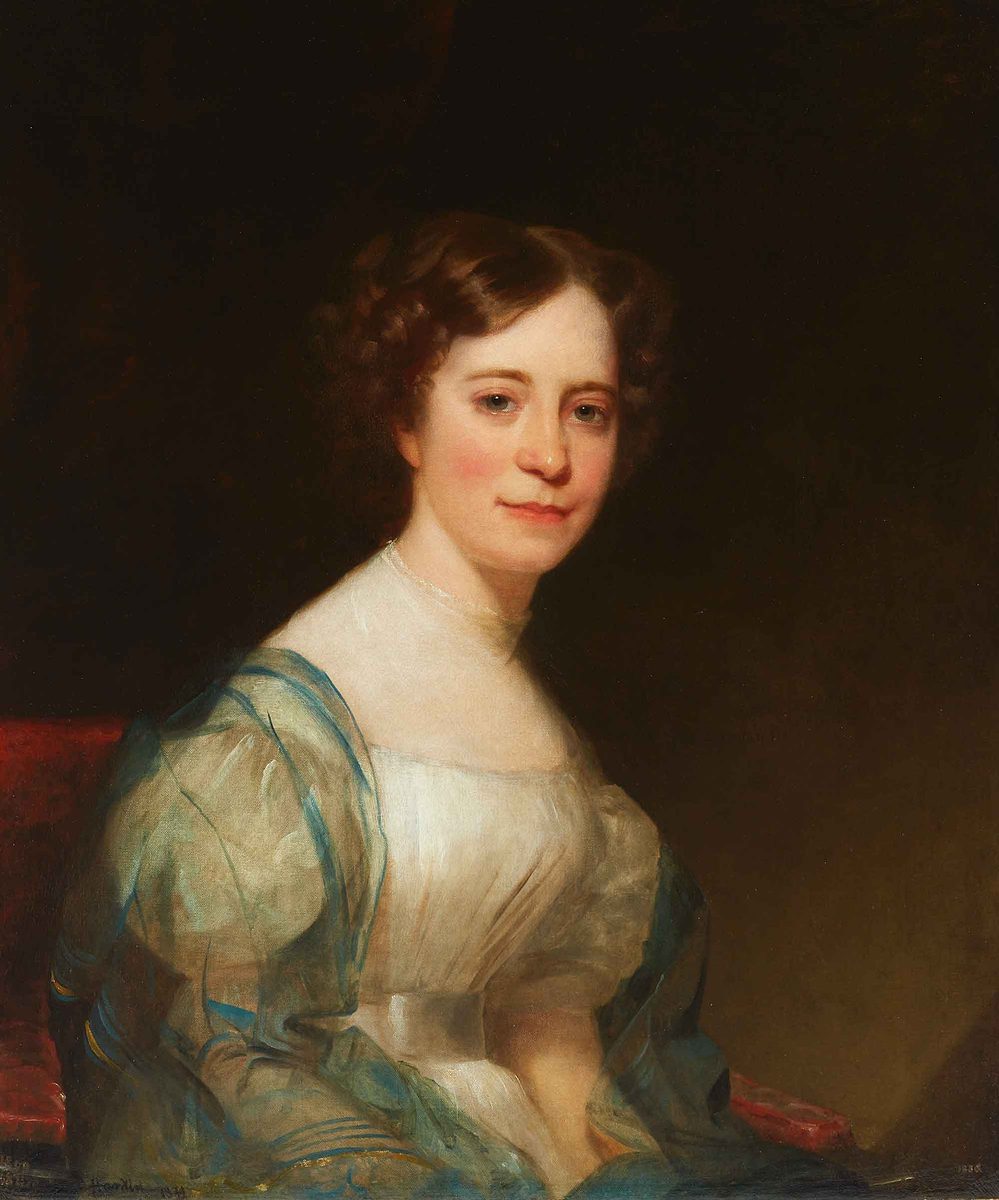When Sophia Peabody met Nathaniel Hawthorne at her home in Salem, Massachusetts, he had little to offer but his Byronic good looks. He had published two books, but they brought him neither fame nor fortune, and at age 33, he had run out of ideas and motivation.
Unbeknownst to Sophia, her sister Elizabeth let Nathaniel read Sophia’s journal of a year and a half in Cuba. Her vivid, candid account of her experiences electrified him and revived his creative energy. Sophia’s story is often told as a footnote to Nathaniel’s, but her talent and intellect were well matched to his.

Night-Blooming Cereus, page from Sophia Peabody’s Cuba Journal, May 27, 1834
| Courtesy of The New York Public LibrarySophia Peabody was born in Salem in 1809 and grew up in the care of a wise and self-reliant mother, Elizabeth Pearse Peabody. Elizabeth believed in the education of women, and in their home she ran a school where girls and boys studied the same curriculum: history, classics, and writing. The reading list included contemporary women writers.
Sophia’s health was never robust—she suffered frequent headaches—but she flourished under her mother’s tutelage. She began taking drawing lessons at age 13, and her teachers were instantly impressed. One remarked that “she never made a false stroke.”1
Sophia studied with some of the leading American painters of her time, including Chester Harding, Thomas Doughty, and Washington Allston. She wrote, “What an intense feeling of delight it gives me to think that I may ever create too.”2 Allston encouraged her to paint from nature rather than follow the conventional discipline of copying other paintings.

Isola San Giovanni, 1839-40 by Sophia Amelia Peabody (American, 1809–1871)
| Courtesy of the Peabody Essex MuseumBy the 1830s, Sophia was exhibiting her work at the Boston Athenaeum and teaching art students of her own. She began selling landscapes to affluent Salem patrons and drawing portraits of family and friends. In 1833, Samuel Gridley Howe recruited her to donate paintings to a fundraising auction for a school that would become the Perkins School for the Blind. Two of her paintings fetched $60—the highest price in the sale.
In 1833, Sophia’s sister Mary got a job as a governess for the children of a wealthy doctor in Cuba. Sophia accompanied Mary in hope that the climate would improve her health. During the next year and a half, Sophia wrote almost 900 pages of letters to her mother, and they would become known as her Cuba Journal. Biographer Megan Marshall writes: “Nature was teaching her that ‘intuition is the unerring truth’ . . . Even before there was a name for it, Sophia had become an instinctive Transcendentalist.”3
After she returned to Massachusetts in 1835, the work of Ralph Waldo Emerson attracted Sophia’s attention. Reading Nature and The American Scholar, Sophia recognized someone who shared her conviction that visible beauty points to a deeper reality.
Her sister Elizabeth had written favorable reviews of some stories by Nathaniel Hawthorne, and in 1837 she invited him to visit her family. Sophia didn’t meet him until his second visit, when “[H]e rose and looked at her intently . . . [with a] piercing, indrawing gaze.”4 It was then that Sophia’s Cuba journal opened new imaginative horizons for Nathaniel.
By 1839 Sophia and Nathaniel were romantically involved, and she drew illustrations for his story, The Gentle Boy. She also began to work in three-dimensional media, making a bust of Perkins School student Laura Bridgman.
In July 1842, Sophia and Nathaniel were married in a ceremony in her sister Elizabeth’s book shop in Boston. On their wedding day, they moved into Concord’s Old Manse, and found Concord was “ideologically [Sophia’s] native land . . . the fertile ground to cultivate indigenously American thought and the literature to express it.”5 The sketch of a night-blooming Cereus in Sophia’s Cuba journal inspired the garden in Nathaniel’s story Rappacini’s Daughter. Nathaniel and Sophia kept a shared journal, reflecting on their new home and the natural world around it. Sophia’s entries are especially vivid, using sexual metaphors to describe nature.
In 1844, Sophia gave birth to a girl they named Una. Sophia immortalized her daughter by engraving this message, preserved on a windowpane at the Old Manse:
“Una Hawthorne stood on this window sill January 22, 1845, while the trees were all glass chandeliers, a goodly show which she liked much, tho’ only ten months old.” 6

Laura Bridgman Bust, 1841 by Sophia Peabody Hawthorne (1809-1871)
| Courtesy of Perkins School for the Blind Archives, Watertown, MA SmithTheir son Julian was born in 1846, and another daughter, Rose, in 1851. Sophia took enthusiastically to motherhood, weaving transcendental themes into the lessons she taught her children. But Nathaniel, by his own account, was “merely a witness to, rather than a participant in, this domestic drama.”7 Sophia saw her creative work being eclipsed by her husband’s.
The Hawthornes, who had left Concord in 1845 because they couldn’t afford the rent, returned in 1852 to buy the big house on Lexington Road that they called The Wayside. This upward mobility was made possible by the success of Nathaniel’s books, The House of Seven Gables and The Scarlet Letter.
They didn’t stay at the Wayside long. Nathaniel’s college friend Franklin Pierce became President of the United States in 1853, and appointed Nathaniel to be U.S. Consul to Liverpool, so they all relocated to England. After Pierce’s presidency ended, the Hawthornes moved to Rome, where Sophia delighted to see magnificent artwork everywhere. She made sketches of the statues and architecture, and was welcomed by a community of single women artists from America who had settled in Rome, including Massachusetts-born sculptors Harriet Hosmer and Louisa Lander.
Returning to Concord on the eve of the Civil War in 1860, Sophia found herself in the uncomfortable role of defending Nathaniel when their antislavery neighbors criticized him for remaining loyal to his old friend Pierce, even as the former President aligned himself with the slaveholding states.
After Nathaniel’s death in 1864, Sophia tried to sort out the train wreck of his finances and edited his half-finished manuscripts for publication. As biographer Patricia Valenti describes it, she was “preserving for posterity her image of the man she had loved.”
She sold the house in Concord, and in 1870 moved with her daughters to England, where she died in 1871. Una, whose health had been precarious since a teenage case of malaria, died six years later. Mother and daughter were buried in London, but both came home to Concord in 2006, when their remains were reinterred alongside Nathaniel at Sleepy Hollow Cemetery.
NOTES
1. Megan Marshall, The Peabody Sisters: Three Women Who Ignited American Romanticism. Houghton Mifflin, 2005 2. Patricia Dunlavy Valenti, Sophia Peabody Hawthorne: A Life, Vol. 1. University of Missouri Press, 2004 3. Marshall, op. cit. 4. Valenti, op. cit. 5. Ibid. 6. A second windowpane at the Old Manse, etched in 1843, records a dialogue between Sophia and Nathaniel. 7. Patricia Dunlavy Valenti, Sophia Peabody Hawthorne: A Life, Vol. 2. University of Missouri Press, 2015


